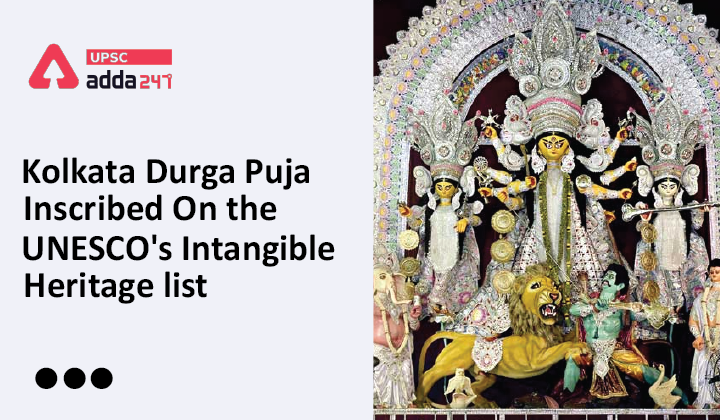Table of Contents
Kolkata Durga Puja- Relevance for UPSC Exam
- GS Paper 1: Indian History- Indian culture will cover the salient aspects of Art Forms, Literature and Architecture from ancient to modern times.
Kolkata Durga Puja- Context
- Recently, UNESCO inscribes ‘Durga Puja in Kolkata’ on the Representative List of Intangible Cultural Heritage of Humanity.
- The Intergovernmental Committee of UNESCO took this decision during its 16th session being held in Paris, France.
- The UNESCO’s Intergovernmental Committee commended Durga Puja for its initiatives to involve marginalized groups, and individuals as well as women in their participation in safeguarding the element.
- With this, the Kolkata Durga Puja became the 1st festival in Asia to achieve recognition as UNESCO ICH (Intangible Cultural Heritage) of Humanity.
Kolkata Durga Puja– Key Points
- History: In literature from around the 16th century we find the first mentions of the grand celebration of Durga puja by zamindars (landlords) in West Bengal.
- Different scripts point to different rajas (kings) and zamindars who celebrated and financed the Durga puja for the whole village.
- The Boendo Bariri Pujo (Puja in the house of zamindars) still remains a custom in Bengal.
- About: Kolkata Durga Puja is a celebration of feminine divinity. Kolkata Durga Puja is also a consummate expression of dance, music, crafts, rituals, practices culinary and cultural aspects.
- The Kolkata Durga Puja festival transcends the boundaries of caste, creed and economic classes and joins the people together in its celebration.
- Time Period of Durga Puja: Kolkata Durga Puja is celebrated in the month of Ashvin (September – October) each year.
UNESCO Creative Cities Network
UNESCO Intangible Cultural Heritages of Humanity
- Origin: UNESCO ICH of Humanity list was established in 2008 when the Convention for Safeguarding of the Intangible Cultural Heritage came into effect.
- About: UNESCO maintains a list of the Intangible Cultural Heritage of Humanity with an aim to-
- Ensure better protection of important intangible cultural heritage across the world and
- To create awareness about the significance of the Intangible Cultural Heritages among people.
- Publishing Authority: UNESCO ICH list is published by the UNESCO’s Intergovernmental Committee for the Safeguarding of Intangible Cultural Heritage.
- Members of the UNESCO’s Intergovernmental Committee for the Safeguarding of Intangible Cultural Heritage are elected by State parties meeting in the United Nations General Assembly.
UNESCO World Heritage Sites in India
UNESCO Intangible Cultural Heritages in India
- India is a culturally diverse country. With the Inclusion of Kolkata Durga Puja, India has now 14 cultural heritages that are included in the UNESCO Intangible Cultural Heritage List.
- UNESCO Recognized Intangible Cultural Heritage of India List is given below-
-
- Tradition of Vedic chanting (2008)
- Ramlila, the traditional performance of the Ramayana (2008)
- Kutiyattam, Sanskrit theatre (2008)
- Ramman, religious festival and ritual theatre of the Garhwal Himalayas (2009)
- Mudiyettu, ritual theatre and dance drama of Kerala (2010)
- Kalbelia folk songs and dances of Rajasthan (2010)
- Chhau dance (2010)
- Buddhist chanting of Ladakh: recitation of sacred Buddhist texts in the trans-Himalayan Ladakh region, Jammu and Kashmir (2012).
- Sankirtana, ritual singing, drumming and dancing of Manipur (2013)
- Traditional brass and copper craft of utensil making among the Thatheras of Jandiala Guru, Punjab (2014)
- Yoga (2016)
- Nawrouz (2016)
- Kumbh Mela (2017)
- Kolkata Durga Puja (2021)
UNESCO State of Education Report 2021





 TSPSC Group 1 Question Paper 2024, Downl...
TSPSC Group 1 Question Paper 2024, Downl...
 TSPSC Group 1 Answer key 2024 Out, Downl...
TSPSC Group 1 Answer key 2024 Out, Downl...
 UPSC Prelims 2024 Question Paper, Downlo...
UPSC Prelims 2024 Question Paper, Downlo...





